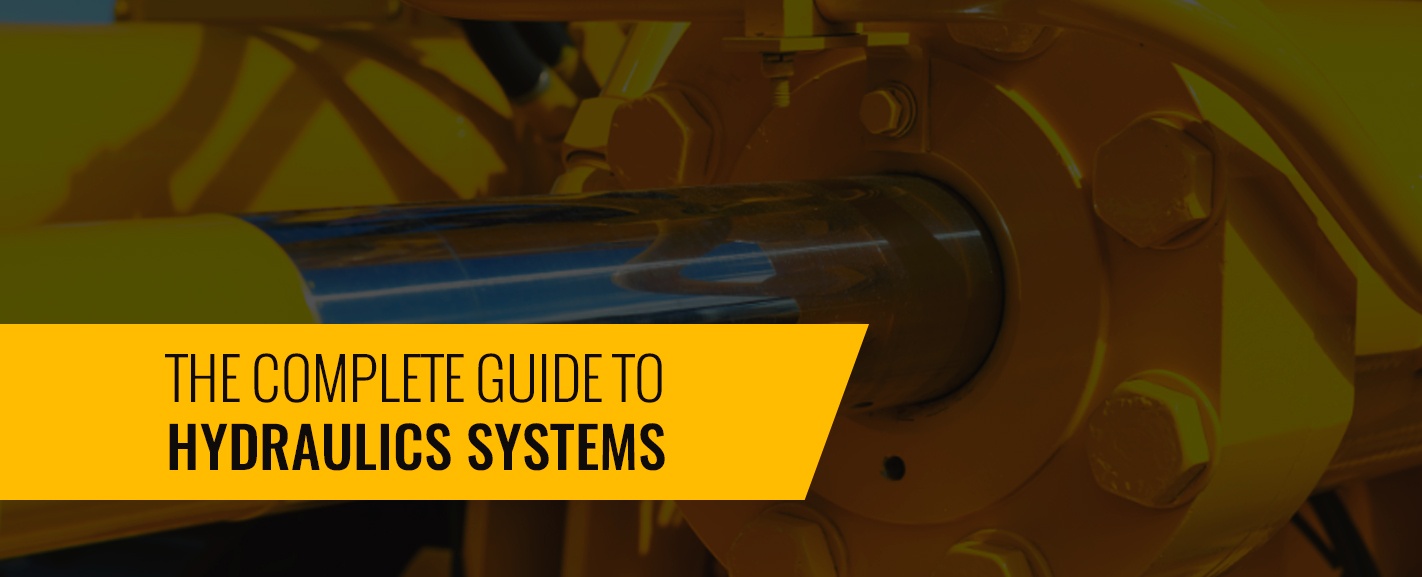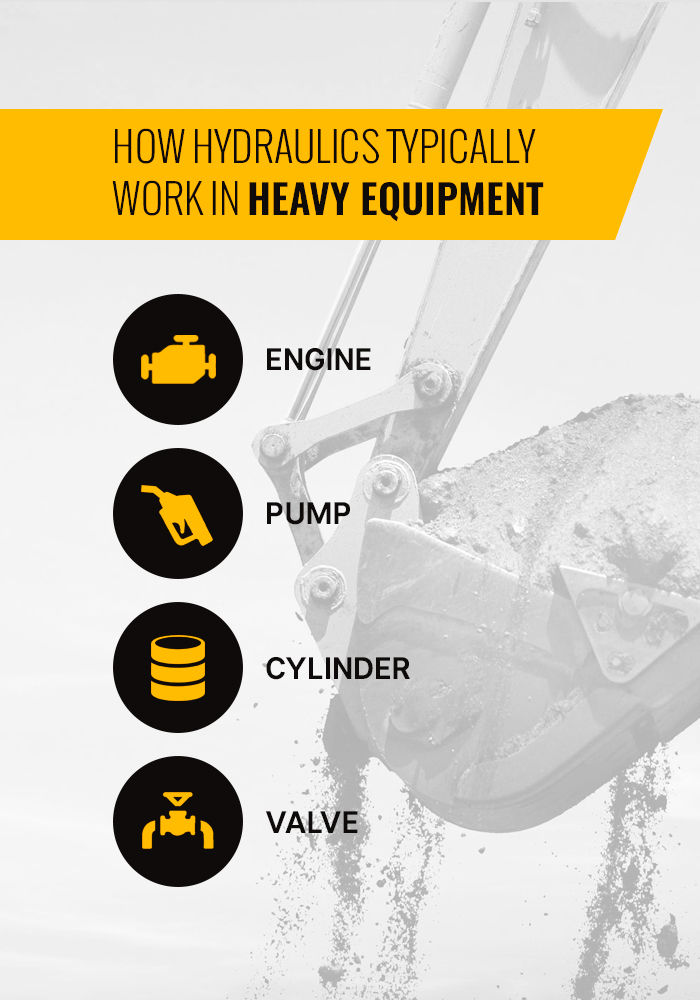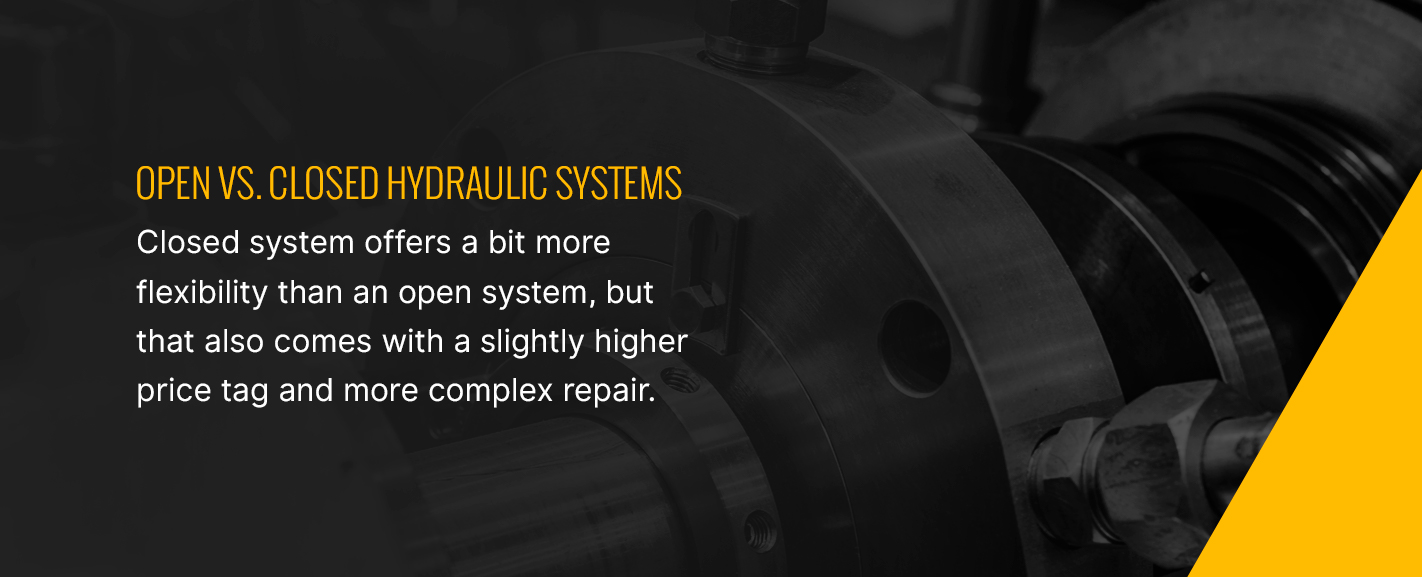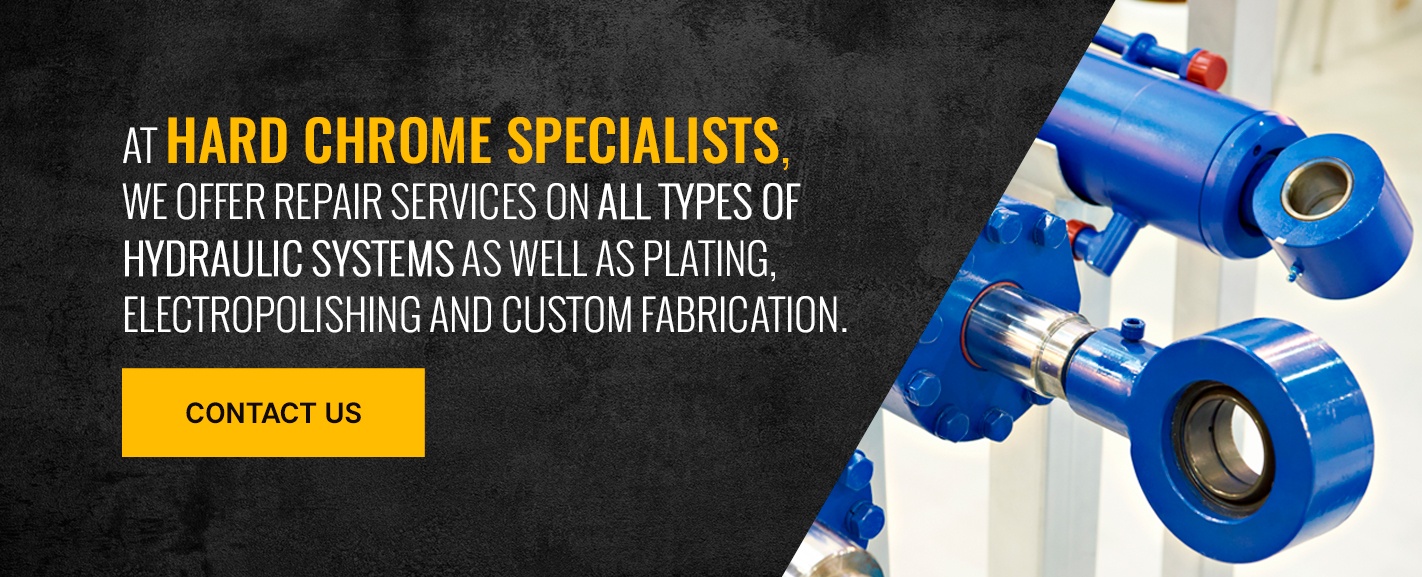How To Set Up Hydraulic System

From the lift you take at piece of work to the dump truck you see rolling past on the street, hydraulics are everywhere. You may be wondering what hydraulics are. This powerful arrangement drives some of the heaviest pieces of machinery out at that place. Hydraulics tin can lift immense loads and operate at high speeds. They are pop on construction sites and a variety of other applications.
There are many types of hydraulic systems with various components, all of which operate under the same principles of energy. Hydraulic pumps pressurize a liquid, and its movement is used to power everything from cranes to cars. In this article, we're going to tell you everything you demand to know about hydraulic systems.
How Does a Hydraulic Organization Piece of work?
Yous're probably already familiar with some of the basic ways a hydraulic organization works and its components. From your feel, y'all probably know that solids are typically impossible to squish. If y'all choice up a solid object like a pen or piece of wood and endeavor to clasp it, nothing's going to happen to the materials. They won't shrink or squish. Liquid works in the aforementioned mode. It is incompressible, significant it won't clasp when you lot apply pressure to it. Information technology takes up the same amount of infinite every bit information technology did when pressure wasn't applied to it. Picture water in a syringe. If you cap the terminate of it with your finger and try to press downwards, neither the water nor the plunger will go anywhere.
Where hydraulic systems are concerned, that incompressibility is a major player in making them piece of work. In that aforementioned syringe, if you lot printing down on the plunger normally, you'll release the water at high speed through the narrow cease, even if you didn't apply that much pressure. When you push downward the plunger, y'all utilise pressure to the h2o, which will endeavor to escape however it can — in this example, at high pressure level through a very narrow go out. This awarding shows united states that we tin multiply force, which nosotros can then use to power more complex devices.
In a very simplified system, a hydraulic organization is made with pipe that has a weight or piston on i cease to compress the liquid. As this weight depresses onto the liquid, it forces information technology out of a much narrower piping at the other terminate. The h2o doesn't squish down and instead pushes itself through the pipe and out the narrow cease at high speed. This organization works in contrary too. If we use a strength to the narrow stop for a longer distance, information technology will generate a forcefulness capable of moving something much heavier on the other end.
Blaise Pascal, a French mathematician, physicist and inventor, standardized these properties in the mid-1600s. Pascal's Principle states that, in a confined space, whatever modify in pressure level practical to a fluid transmits through the fluid in every direction. In other words, if you apply pressure to 1 cease of a container of water, the aforementioned pressure will be practical to the other side. This principle is what allows the force to be multiplied and bear on a larger, heavier object.
There is a petty bit of a trade-off with this organisation. You tin can typically apply more force or more speed to one end to see the opposite result on the other. For example, if you press downward on the narrow end with high speed and depression force, yous'll apply loftier force but low speed to the wide end. The distance your narrow finish tin travel would also influence how far the broad ane volition movement. Trading distance and force is typical in many systems, and hydraulics are no exception.
The multiplication of force is an influential factor in lifting heavy objects. If the piston in the broader side is six times the size of the smaller ane, then the force applied to the fluid from the larger piston volition exist six times as powerful on the smaller end. For example, a 100-pound force down at the wider end creates a 600-pound forcefulness up at the narrow end. This force multiplication is what allows hydraulic systems to exist relatively minor. They are corking for powering huge machines without taking upwardly too much infinite.
Hydraulics can likewise exist very flexible, and there are many different types of hydraulic systems. Yous can move the fluids through very narrow pipes and snake them effectually other equipment. They have a diverseness of sizes and shapes and tin even branch off into multiple paths, allowing one piston to power several others. Car brakes are commonly an case of this. The brake pedal activates two master cylinders, each of which reaches 2 restriction pads, one for all wheels. You can find hydraulics powering a multifariousness of components through cylinders, pumps, presses, lifts and motors.
Hydraulic systems have a few essential components to control how they work:
- Reservoir: Hydraulic systems normally use a reservoir to hold excess fluid and power the mechanism. It is of import to cool the fluid, using metal walls to release the rut generated from all the friction it encounters. An unpressurized reservoir can too permit trapped air to leave the liquid, which helps efficiency. Since air compresses, it can divert the movement from the pistons and make the organisation work less efficiently.
- Fluid: Hydraulic fluids can vary, only they are typically petroleum, mineral- or vegetable-based oils. The fluids can have different backdrop based on their awarding. Restriction fluid, for example, needs to take a high humid betoken due to the high-oestrus mechanism information technology goes through. Other features include lubrication, radiation resistance and viscosity.
Let's take a wait at how hydraulics typically piece of work in heavy equipment:

- Engine: This is commonly gasoline-powered and allows the hydraulic arrangement to piece of work. In big machines, this needs to be capable of generating a lot of power.
- Pump: The hydraulic oil pump sends a flow of oil through the valve and to the hydraulic cylinder. Pump efficiency is frequently measured in gallons per infinitesimal and pounds per square inch (psi).
- Cylinder: The cylinder receives the high-pressure fluid from the valves and actuates the move.
- Valve: Valves help to send the fluid around the arrangement by controlling things like pressure, management and flow.
Other machines that make use of hydraulics include vehicles on construction sites. Diggers, cranes, bulldozers and excavators tin all exist run by robust hydraulic systems. A digger, for example, powers its massive arm with hydraulic-powered rams. The fluid is pumped into the sparse pipes, lengthening the rams and, past extension, the arm. The hydraulic power backside this can be used to lift enormous loads. Aside from construction machines, hydraulics are used for everything from elevators to motors, fifty-fifty in airplane controls.
What is the Difference Betwixt Open up vs. Closed Hydraulic Systems?
Open and closed systems of hydraulics refer to dissimilar ways of reducing force per unit area to the pump. Doing this tin help reduce whatever wear and tear.
In an open organisation, the pump is ever working, moving oil through the pipes without edifice up pressure. Both the inlet to the pump and the return valve are hooked up to a hydraulic reservoir. These are besides called "open eye" systems, because of the open central path of the control valve when it is neutral. In this case, hydraulic fluid returns to the reservoir. The fluid coming from the pump goes to the device and and then returns to the reservoir. There may also be a relief valve in the circuit to route any excess fluid to the reservoir. Filters are usually in place to proceed the fluid clean.
Open systems tend to be meliorate for low-pressure level applications. They besides tend to be cheaper and easier to maintain. One caution is that they can create excess estrus in the system if the force per unit area exceeds valve settings. Another location for added estrus is in the reservoir, which needs to exist big enough to cool the fluid running through it. Open up systems tin likewise use multiple pumps to supply ability to different systems, such as steering or command.
A closed system connects the render valve directly to the hydraulic pump inlet. It uses a single key pump to move the fluid in a continuous loop. A valve also blocks oil from the pump, instead sending it to an accumulator where it stays pressurized. Oil remains under pressure merely doesn't motion unless it is activated. A charge pump supplies cool, filtered oil to the low-pressure side. This step maintains pressure within the loop. A closed system is often used in mobile applications with hydrostatic transmissions and uses one pump to power multiple systems.

These can have smaller reservoirs because they only need to take plenty fluid for the charge pump, which is relatively small. An open system can handle more high-pressure applications. The closed system offers a bit more flexibility than an open up system, but that also comes with a slightly higher price tag and more than complex repair. Closed systems tin piece of work with less fluid in smaller hydraulic lines, and the valves can be used to reverse the management of the flow.
You can even convert an open up arrangement into a closed system by replacing some of the components and calculation infinite for the oil to become after the return trip.
Types of Hydraulic Pumps
There are several different types of hydraulic pumps. These can vary significantly in the means that they move fluid and how much they displace.

About all hydraulic pumps arepositive deportation pumps, meaning they deliver a precise amount of fluid. They can be used in high-power applications of over 10,000 psi.Non-positive displacement pumps depend on force per unit area for the corporeality of fluid they motility, while positive deportation pumps do not. Non-positive pumps are more common in pneumatics and low-pressure applications. They include centrifugal and axial pumps.
Positive displacement pumps can accept either fixed or variable deportation. Most pumps fall under stock-still displacement.
- Infixed displacement, the pump provides the aforementioned corporeality of fluid in each pump cycle.
- Invariable deportation, the pump tin provide different amounts of fluid based on the speed information technology is run at or the physical properties of the pump.
Agear pump is inexpensive and more tolerant of fluid contamination, making them suitable for crude environments. They may be less efficient, nonetheless, and habiliment more than apace.
- External gear pumps: These make use of two tight-meshed gears inside a housing. One is the driving, or powered, gear, while the other is driven, or complimentary-flowing. The fluid is trapped in the space in between the gears and rotated through the housing. Since it cannot motion backward, it is forced through the outlet pump.
- Internal gear pump: The internal gear pattern places an inner gear, peradventure with a crescent-shaped spacer, inside of an outer rotor gear. The fluid is moved via eccentricity — the departure of the gear from circularity — between the gears. The inner gear, with fewer teeth, turns the outer gear, and the spacer goes in betwixt them to create a seal. The fluid is drawn in, moved through the gears, sealed upwards and discharged.
Next up isvane pumps. These tin be unbalanced or counterbalanced and stock-still or variable-deportation. They are quiet and work in pressures under 4,000 psi.
- Unbalanced vane pump: This fixed displacement pump has a driven rotor and vanes that slide out in radial slots. The rotor'southward level of eccentricity determines the level of displacement. As it rotates, the space between the vanes increases, creating a vacuum to draw fluid in. The trapped fluid moves effectually the system via the rotating vanes and is pushed out as the space between them decreases.
- Balanced vane pump: The balanced vane pump, likewise stock-still displacement, moves the rotor through an elliptical cam ring. It uses 2 inlets and outlets on each revolution.
- Variable-displacement vane pump: The displacement in this type of pump can modify via the eccentricity between the rotor and casing. The outer casing ring is moveable.
Our last category of pumps ispiston pumps, which are great for high-powered applications.
- In-line axial piston pumps: In-line pumps marshal the center of the cylinder block with the center of the driveshaft. The angle of the swash/cam plate helps to decide the amount of displacement. The inlet and outlet are located in the valve plate, which connects to each cylinder alternately. Equally the piston moves upward past the inlet port, information technology pulls in fluid from the reservoir. Similarly, it will push the liquid out of the outlet port as it passes it.
- Bent-axis axial piston pumps: The bent-axis pumps line the heart of the cylinder block at an angle with the center of the bulldoze shaft. This design works similarly to the in-line axial pump.
- Radial piston pumps: A radial piston pump uses seven or nine radial barrels, along with a reaction ring, pintle and driveshaft. The pistons are ready radially around the drive shaft, and inlet and outlet ports are in the pintle, a type of hinge.
Acquire More About Hydraulics
At present that you know what hydraulics are, you tin see that hydraulics have vast applications and can be used in all sorts of different components of the mechanism that runs construction, transportation and more. You may even be able to think of some hydraulic organization examples of your ain at present. The power of water has been used for centuries, and now, with the help of valves, pistons and cylinders, hydraulics can run in a variety of dissimilar formats. Open and closed, stock-still or variable, positive and non-positive — all of these can move massive weights and take advantage of modern technology. If you run any sort of business organisation, you lot may be able to put hydraulics to piece of work for you.

At Hard Chrome Specialists, we offering repair services on all types of hydraulic systems as well equally plating, electropolishing and custom fabrication. Nosotros hope you've learned something new today about how hydraulics work and understand a little more than about this incredibly powerful system. If yous want to learn more about hydraulics, contact us today!
How To Set Up Hydraulic System,
Source: https://hcsplating.com/complete-guide-to-hydraulics-systems/
Posted by: shepherdmajected.blogspot.com


0 Response to "How To Set Up Hydraulic System"
Post a Comment